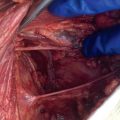Abstract
Nipple discharge is a common breast symptom that warrants evaluation. Although most discharges are due to benign conditions, discharge may be due to an underlying malignancy. This chapter reviews the potential etiologies of nipple discharge and the appropriate workup, including the role of ductography, ductoscopy, and magnetic resonance imaging. Algorithms for workup and management of nipple discharge are presented. The technique of duct excision is outlined. This chapter also examines the significance of nipple secretions with respect to breast cancer risk and the technology for obtaining nipple secretions for cytologic examination for risk assessment.
Keywords
nipple discharge, ductoscopy, ductography, nipple aspiration, fluid papilloma
Introduction and Definitions
Nipple discharge prompts the majority of women to seek immediate attention from their physician. Women view nipple discharge as a potential indicator of breast cancer. Thus it is critical for a physician caring for women with breast disease to have a comprehensive understanding of the physiology of breast secretions and the clinical significance of secretions and discharges. In this chapter, we review the pathophysiology of nipple discharge as well as the significance of breast secretions with respect to the risk of breast cancer. A review of the clinical management and evaluation of nipple discharge follows. This chapter includes a description of methods for collection and preparation of nipple fluid for analysis, ductoscopy, and surgical management of nipple discharge.
The terms discharge and secretion of the nipple are defined as follows: discharge is fluid that extrudes spontaneously from the nipple. Secretion refers to fluid present in mammary ducts that can be collected by nipple aspiration or by other means that include conventional breast pump or massage and expression from the ducts (nonspontaneous secretion). Ductal lavage fluid refers to the application of saline washing into individual breast ducts with fluid retrieval via a microcatheter device.
The breast is a secretory gland that shows evidence of secretory activity under influence of maternal hormones initiated in in utero and under sex hormones during puberty and adult reproductive life. With the estrogen-progestin hormonal cycle, breast epithelium undergoes cellular proliferation in the estrogenic phase, followed by secretory activity. Breast tissue studies confirm cyclical changes related to follicular and luteal phases. Similar observations on changes in histologic pattern, cellular morphology, mitoses, and DNA content are evident. Longacre and Bartow found excessive lymphocytes, duct epithelial degenerative changes, and sloughing into duct lumens in the late secretory and early menstrual phases. Ferguson and Anderson also confirmed cell depletion through a process of apoptosis in this time interval, which peaks on day 28.
Objective measures of breast epithelial cyclical changes can be determined with image cytometry of fine-needle aspiration (FNA) samples. In FNA biopsies, image cytometry assessing five nuclear features—area, circumference, boundary fluctuation, chromatin granularity, and stain intensity—successfully discriminated samples from women in follicular phase and those in luteal phase. Because the proliferative changes in the postovulatory phase can mimic atypia or malignancy, Malberger and colleagues recommended that FNA be used only in the preovulatory phase. These potentially confusing histologic changes in the sampled cells should be taken into account when evaluating cytologic features of nipple discharges and nipple fluid aspirates.
The functional unit of the breast is the terminal duct lobular unit (TDLU) ( Fig. 4.1 ). Mammary secretions originate in the lobules. Lobules are connected by the intralobular ducts to the extralobular ductal system, which empties into the lactiferous sinus and onto the vestibule of the nipple. Anatomically, the breast has 15 to 20 segments, each assumed to have unique drainage ( Fig. 4.2 ). Love and Barsky challenged this anatomic concept. Applying several methodologies to study the nipple ducts, it was shown that 90% of nipples contain five to nine ductal orifices distributed in two groups: central and peripheral. The central ducts extend back from the nipple toward the chest wall, and the peripheral ducts extend radially. The separate ductal systems do not connect or anastomose.
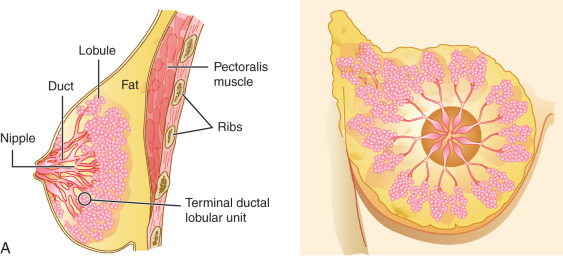
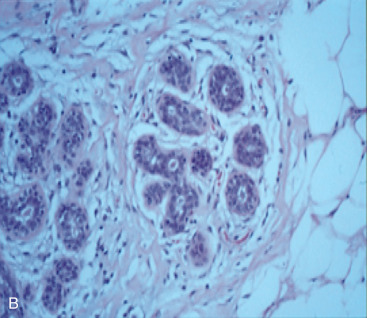
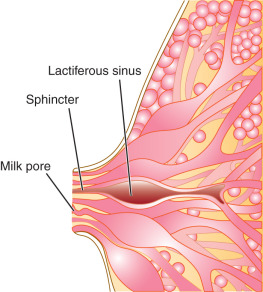
Nipple secretion is usually not clinically evident in nonlactating women because keratotic debris obstructs passage into lactiferous sinuses, but secretory material can be seen in the duct lumen in histologic sections of breast tissue. By removing the keratotic debris, the physician may easily obtain nipple fluid from a large proportion of women using a simple nipple aspirator device breast pump or manual expression.
Nipple Aspiration Fluid: Characterization and Significance
Many investigators have an interest in intraductal physiology and cytology as an indicator of risk of breast cancer. It is thought that breast cancer results from a cascade of sequential molecular and morphologic events that occur in the ductal epithelial cells. If that process can be detected before transition to a malignant phenotype, there is the opportunity for prevention strategies ( Fig. 4.3 ). The methodologies for obtaining breast secretions and classifying cellular patterns, as well as the biochemical makeup of nipple aspiration fluid (NAF), are discussed in this section.

NAF is a simple, minimally invasive method of sampling histologic alterations within the breast. After cleaning of the nipple orifice to remove keratin plugs, the breast is massaged from the base to the nipple. Using a modified breast pump ( Fig. 4.4 ), suction is applied to elicit the fluid. NAF appears as droplets on the nipple and is collected with small capillary tubes. Samples are usually pooled for examination to improve cellular yield.
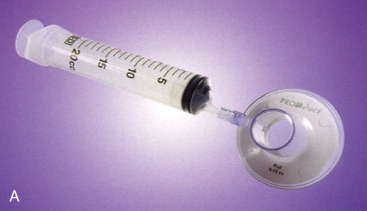
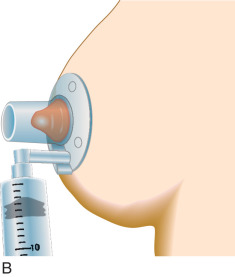
Cytologic examination of the breast fluid has long been considered a potential aid in the detection of breast disease. Saphir (1950) and Ringrose (1966) reported the cytologic criteria for the diagnosis of chronic mastitis, intraductal papillomas, and carcinoma based on stained smears of spontaneous nipple discharge.
After the successful application of the cervical smear (Pap smear) for the diagnosis of cervical cancer, George Papanicolaou developed the concept of a “Pap smear” for breast cancer. In 1950 Papanicolaou began a study to investigate normal, atypical, and malignant breast epithelia. In this study, he examined breast aspirates in 917 asymptomatic patients. Using a breast pump, secretions were obtained unilaterally in 171 (18.5%) and bilaterally in 74 (8.1%). Premenopausal women yielded a higher percentage of fluid than postmenopausal women, with the highest percentage found in women 20 to 39 years of age. Four occult carcinomas and one ductal carcinoma in situ (DCIS) were found. Papanicolaou also sought to define “normal” cytologic findings in nipple fluid. The two cell types most often encountered were foam cells and duct epithelial cells. Scant histiocytes and lymphocytes were also present.
In the 1970s, using a modified breast pump, Sartorius and associates attempted nipple aspiration in 1503 women with suspected breast disease and 203 asymptomatic volunteers. They developed the histologic classification to define cytologic changes; it required a minimum of 50 to 100 cells for diagnosis. Diagnostic categories included the following:
- •
Normal: all duct lining cells uniform in size and staining characteristics
- •
Hyperplasia: excessive number of ductal groups with multilayering and slight variations in size and shape, but without significant nuclear abnormality and a constant nucleocytoplasmic ratio
- •
Atypical hyperplasia: criteria similar to that used for hyperplasia but with greater variation in nuclear size and shape, abnormal distribution of chromatin and increased nuclear: cytoplasmic ratio and prominent nucleoli
- •
Suspected carcinoma: criteria similar to atypical hyperplasia but with marked nuclear abnormality, chromatin clearing, nuclear membrane irregularity, and nucleoli
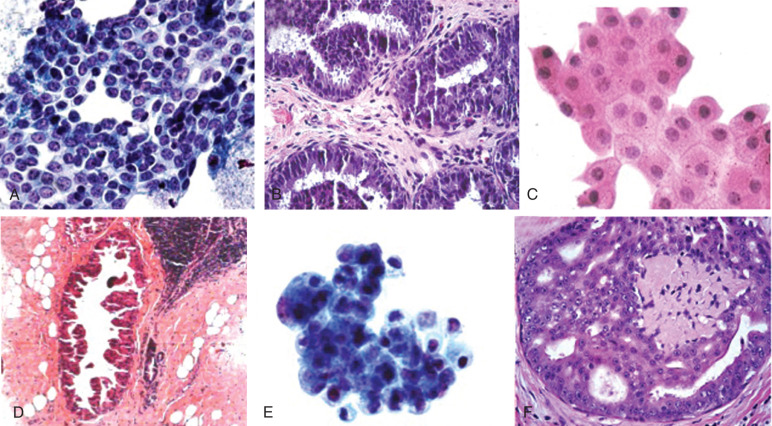
Of the 203 asymptomatic volunteers, NAF was obtained in 163 (80%), with adequate cellular samples obtained in 48.7%. Of the 1503 women with breast disease, NAF with adequate cellularity was obtained in 825 (54.9%); 11.2% yielded fluid without adequate cells. Women 31 to 50 years of age (65%) gave cellular samples, and those older than 60 years of age yielded less fluid. Of the 825 women who yielded fluid, 237 were classified as high risk on the basis of factors such as family history and history of prior breast surgery. A significantly larger percentage of high-risk women had abnormal cytology compared with the normal risk group. This association was seen more frequently in women older than 40 years.
Petrakis and King further validated the association of atypical epithelial cells in NAF of asymptomatic women with histologically confirmed proliferative disease and atypical hyperplasia. This finding was particularly evident among women at increased risk for breast cancer. These authors first proposed the finding of atypical cells in NAF as a possible marker to identify women at risk who would need close surveillance.
King and coworkers conducted a cytologic-histologic correlation study of NAF among 82 women with cancer and 237 women subsequently diagnosed with benign breast disease. In this analysis of 134 samples (34 cancer; 100 noncancer), patients met the criteria for the presence of a minimum of 10 cells. Atypical hyperplasia in NAF was present in 80% of cancers and 39% of benign breast diseases. The diagnosis of cancer was made in only 21% of the cases. NAF was proposed as a novel approach to study breast cancer precursors but was not considered a diagnostic tool. Factors that affect NAF production in nonlactating women include age, existing proliferative breast disease, previous breast biopsy, and family history of breast cancer.
In a large prospective trial to determine breast cancer risk in relation to NAF, Wrensch and coworkers enrolled 2701 nonlactating women between 1973 and 1980 and reported their long-term follow-up (average, 12.7 years) in 1991. In this study, women who did not yield any fluid were described as the referent group because they represent the lowest risk of developing breast cancer. With follow-up at 87%, the study confirmed that women with atypical hyperplasia were 4.9 times more likely to develop breast cancer compared with non–NAF-producing patients; this risk was 2.8 times more likely compared with women with normal cytology ( Fig. 4.6 ). The increase in the risk of breast cancer with abnormal cytology was more pronounced in younger (25–54 years) versus older (>55 years) women. Women with atypical NAF and family history of breast cancer were six times more likely to develop breast cancer than women with atypical hyperplasia but without a family history of breast cancer. The study concluded that women with cytologic diagnosis of atypical hyperplasia experienced a significant increase in risk of developing breast cancer.
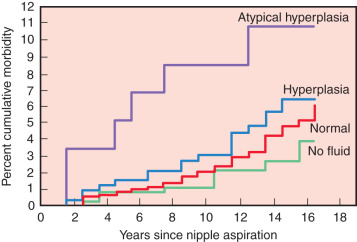
In 2001 Wrensch and colleagues reported their findings on extended follow-up of 3627 volunteers. This study demonstrated that 3.5% of women developed breast cancer (median of 12 years follow-up), and 7.8% developed cancer in the median of 21 years follow-up. Women with NAF production were more likely to develop breast cancer than the non–NAF-producing group. This long-term follow-up data upheld their previous findings of increased risk for developing breast cancer related to abnormal cytology.
Sauter and associates used a modified breast pump to collect NAF in 177 patients with a success rate of 94%; evaluable cytology was obtained in 95%. NAF cytology correlated with increased risk of breast cancer. Birth control pills, hormone replacement therapy, or phase of menstrual cycle had no influence on NAF production. These authors were successful in obtaining NAF in postmenopausal women and advocated the use of NAF as a screening tool and as a marker for chemoprevention.
Biochemical Composition of Nipple Aspiration Fluid
The noncellular component of the NAF has been studied for a number of biochemical substances and biomarkers. In a prospective study of patients planned for excisional breast biopsy, NAF was evaluated for candidate proteins such as prostate-specific antigen (PSA), human glandular kallikrein (hK2), basic fibroblast growth factor (bFGF), and cellular markers such as S-phase fraction, as well as for DNA index and cytology. The best breast cancer predictive model included cytology, bFGF, and age (88% sensitivity; 57% specificity). Incorporation of menopausal status to predict the optimal model of breast cancer indicates NAF hK2 or PSA and age to be 100% sensitive and 41% specific in premenopausal versus 93% sensitive and 12% specific in postmenopausal women.
Subsequently, the focus for NAF has shifted from studying healthy volunteers or women with benign breast disease for comparison of NAF from a breast with cancer to the healthy contralateral breast. Kuerer and coworkers prospectively determined the concentration of extracellular domain of Her2 in affected versus nonaffected breasts and found NAF Her2 levels to be highly correlative ( r = 0.302; p = .038); tumors that overexpressed Her2 had higher Her2 levels in the affected versus the nonaffected breast. Zhang and colleagues reported that microarray profiling of nipple discharge for microRNAs (miRNAs) revealed that three miRNAs were upregulated and three miRNAs were downregulated in intraductal carcinoma breast cancer patients compared with those with benign papilloma. In addition, NAF contains chemical substances of exogenous origin, such as caffeine, nicotine, pesticides, and orally ingested drugs. Approximately 10% of NAF samples have substances with mutagenic activity that could portend the development of breast cancer. These types of analyses may serve as potential diagnostic tools for breast cancer.
Minimally Invasive Techniques for Determining Risk of Breast Cancer
Ductal Lavage
Although quite promising, NAF cytology has major limitations in clinical screening because of the inconsistency of adequate cellular yield and the presumption that nipple aspiration fails to harvest cells from the distal portion of the duct-lobular system. To overcome these limitations, a new approach was developed in 1999 that allows collection of higher numbers of exfoliated cells from the TDLU. The ductal lavage (DL) procedure involves nipple aspiration using a modified suction cup to localize the NAF-yielding ducts. NAF-yielding ducts can subsequently be localized and cannulated using a microcatheter (Hologic, Bedford, MA). Fluid-yielding ducts are infused with normal saline. Ductal effluent collected through the microcatheter is then analyzed cytologically ( Fig. 4.7 ).
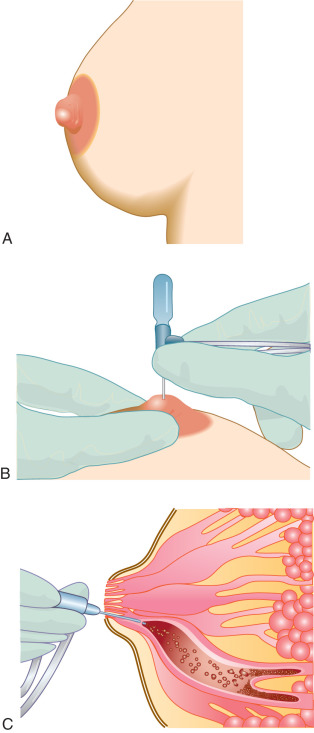
The DL technique was first attempted during a breast duct endoscopy study in which dilators were introduced into the ducts. Thereafter, a cannula (outer diameter, 0.4 mm) was inserted into the duct and saline was injected to wash the ductal lumen. The washings were collected and studied cytologically. The technique was later refined with special development of a double-lumen catheter. Dooley and colleagues designed a prospective multicenter study to compare DL and nipple aspiration with regard to safety, tolerability, and outcomes for detection of abnormal cells. The effluent was collected and cytologic preparations were performed using the Millipore technique (also used in early NAF studies). The study enrolled 507 women, 291 (57%) of whom had a history of breast cancer and 199 (39%) had a Gail risk of breast cancer of 1.7%. The minimum age was 52 years. Overall, the procedure was tolerated well. NAF was obtained in 417 women, and DL was performed in 383. On average, the NAF had 120 epithelial cells compared with 13,200 epithelial cells in the DL samples. Greater cellularity and high diagnostic yield was also noted in DL samples. Importantly, atypia was diagnosed in 24% of the DL versus 10% of NAF samples. Only ducts yielding NAF were targeted for DL (average 1.5 ducts/breast were lavaged).
Ductal Lavage Procedure.
Preparation for the DL procedure is labor- and time-intensive; the technique requires breast massage for 30 minutes. A topical anesthetic (2.5% lidocaine and 2.5% prilocaine [EMLA]) is applied. Keratin plugs are removed from the nipple. The nipple suction device is used to obtain NAF and localize the ducts that can be cannulated. A grid can be used to record the location of the ducts for future reference. Usually 5 to 10 mL of saline are infused, collected, and submitted to a cytology laboratory in CytoLyt (Cytyc) solution. In the laboratory, a ThinPrep slide can be prepared and stained using the routine Papanicolaou stain. The diagnostic categories used for reporting DL cytology were developed by Wrensch and coworkers and were further refined using the National Cancer Institute Consensus Conference Statement on breast FNAs. The categories included the following:
- •
Insufficient cellular material for diagnosis: A minimum of 10 epithelial cells should be present per slide. The presence of macrophages alone does not render a specimen diagnostic.
- •
Benign: Samples categorized as benign contain 10 or more epithelial cells and variable number of other cellular components such as squamous cells, lymphocytes, and foamy macrophages. The benign duct epithelial cells are 10 to 15 µm in diameter and have a cyanophilic cytoplasm that may contain fine vacuoles. Ductal cells are more easily recognized in groups than in single cells, which are difficult to differentiate from lymphocytes. Cells may be arranged in monolayer sheets or strands.
- •
Mild atypia: In mild atypia, there is nuclear enlargement 1.5 to 3 times the normal ductal cell, and higher nuclear-cytoplasmic ratio. The nucleus may be hyperchromatic or hypochromatic and there may be nucleoli. Multilayering or complex and papillary architectural groups may be present and usually indicate hyperplastic changes.
- •
Marked atypia: The preceding abnormalities are more pronounced, nucleoli are more prominent, and nuclear membrane irregularities are easily appreciable.
- •
Malignant cells: Malignant cells on DL have obvious features of malignancy with high nuclear-cytoplasmic ratio, hyperchromasia, macronucleoli, and dyshesion ( Figs. 4.8 and 4.9 ).
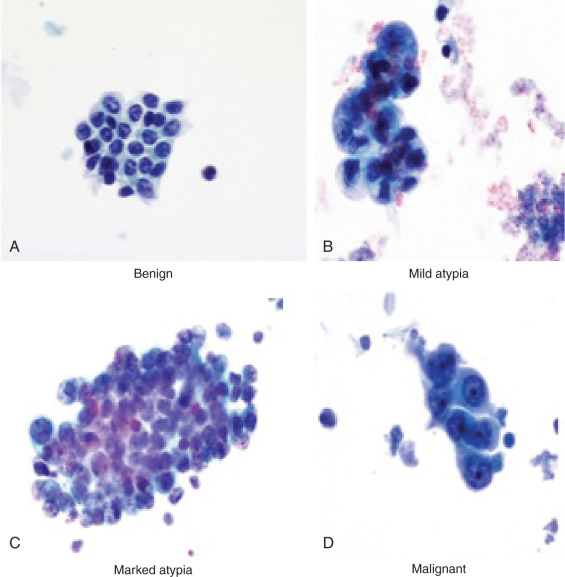
Fig. 4.8
(A) to (D) Spectrum of cytology on nipple duct lavage.
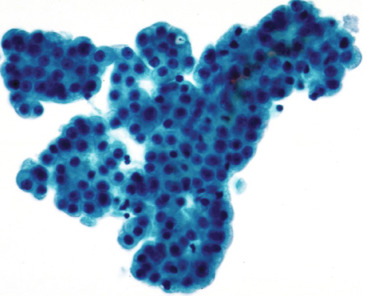
Fig. 4.9
Cytologic features of intraductal papilloma on nipple duct lavage.
The diagnosis of malignancy on DL is uncommon because the large majority of women who undergo the procedure have no palpable or mammographic abnormality. Occasionally, however, a high-grade DCIS may be diagnosed in this manner. In Dooley’s study, less than 1% of cases were diagnosed as malignant.
Limitations of Ductal Lavage.
The procedure is not widely available. The cost of disposables is high. Special expertise and training is required for the performance of DL. Cytologic interpretation may be variable and training is required for pathologists to become familiar with DL cytology. DL detects milder atypia than NAF (17% vs. 6%). It remains to be seen, however, as in NAF, whether mild atypia poses an increased risk. The negative predictive value (NPV) of the procedure is not known (i.e., number of women at increased risk with negative DL who will develop breast cancer).
There are also important limitations to the nipple DL (NDL) methodology. Maddux and colleagues evaluated the atypia rate by NDL fluid-producing ducts compared with non–fluid-producing ducts and the atypia rate in high-risk versus low-risk patients. Fifty-five women with 226 ducts were lavaged, resulting in 136 ducts producing fluid versus 90 ducts producing no fluid. Of these, 44% had a Gail risk index greater than or equal to 1.7, and 56% had a Gail risk index less than 1.7%. Cytologic atypia was diagnosed in 34% of patients. The cytologic atypia rate was not statistically different in low-risk versus high-risk women based on a Gail index (33% vs. 35%; p = 1) or fluid-producing versus non–fluid-producing ducts (19% vs. 15%; p = .61), respectively. In this study, there was a higher atypia rate for fluid-producing ducts versus non–fluid-producing ducts (32% vs. 11%) in women at high-risk (Gail risk ≥1.7).
Another limitation of NDL is the lack of studies related to the performance characteristics of the procedure. It is possible that some atypical lavages may reflect underlying atypical hyperplasia, whereas others may reflect reversible physiologic changes. Johnson-Maddux and associates proposed that persistent lavage atypia may be related to underlying pathology such as atypical duct hyperplasia, whereas reversible atypia may be associated with physiologic changes. In a reproducibility study for NDL, Maddux and associates found marked atypia in 36% of breasts with incident carcinoma and in 24% of benign breasts ( p = .19). However, marked atypia was diagnosed more frequently in breasts with an incident carcinoma (22%) than in unaffected breasts (7%; p = .01). Interestingly, the insufficient sample rate was higher for ducts in breasts with an incident carcinoma (40%) than for ducts in breasts unaffected with carcinoma (27%; p = .06). Thirty-two patients with atypical lavage from the unaffected breast underwent repeat lavage at median 8.3 months, with atypia occurring in only 48%. The number of duct orifices presents a challenge in reidentification with repeat lavage. Reproducibility is also affected by variables such as hormonal changes and number of cells and cytologic interpretation. The insufficient rate on repeat lavage was 29%. The higher prevalence of lavage atypia, along with low reproducibility, limits the use of a single NDL in predicting high risk of breast carcinoma.
Ductal Lavage and Molecular Markers.
In addition to routine cytology, DL may permit analysis of molecular markers associated with breast carcinoma. Cytologic preparations of DL can be used for immunocytochemical analysis. Molecular cytogenetics analysis by King and colleagues on 39 paired cases of DL and surgically excised breast lesions revealed interphase fluorescent in situ hybridization (FISH) cytogenetic changes on chromosomes 1, 8, 11, and/or 17 in 10 of 14 (71%) malignant tumors versus 2 of 18 (11%) from benign neoplasms ( Fig. 4.10 ). This study confirms the potential utility of FISH as a future adjunctive technique. In another study by Yamamoto and associates, DL was performed in women with nipple discharge and abnormal ductography. None of the samples collected from 54 benign cases showed aneusomy for chromosomes 1, 11, and 17, giving a specificity of 100%, whereas aneusomy of at least three of these chromosomes was seen in all six malignant cases. In the future, the adjunctive use of FISH may be helpful in improving the discriminatory value of cytology.
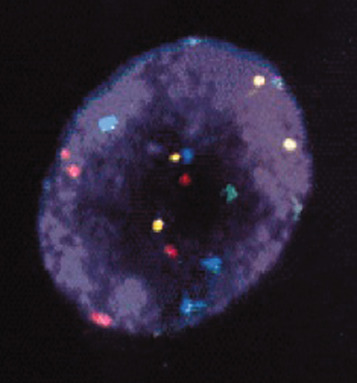
Similarly, Evron and coworkers performed methylation-specific polymerase chain reaction (PCR), or MSP, for cyclin D2, RAR B, and Twist genes on DL specimens. At least one of the genes was methylated in 96% of surgically excised primary tumors and 57% of DCIS, but not in normal breast tissue, resulting in high sensitivity and specificity. Thirty-seven women with biopsy-proven cancers underwent DL. On MSP, 17 of 20 women (85%) also had at least one gene methylated in the DL sample. All four women with negative DL were additionally observed to be negative by MSP. These data demonstrate the feasibility for the early detection of molecular markers in DL, which may play a role in the early detection of breast cancer.
Euhus and colleagues measured the prevalence of tumor suppressor gene methylation by quantitative multiplex methylation-specific PCR (QM-MSP) for cyclin D 2 , APC, HIN1, RASSF1A, and RAR-β2. Methylation of at least two genes correlated with marked atypia in univariate analysis but not in multivariate analysis that was adjusted for sample cellularity and risk group stratification. This study concluded that both methylation and marked atypia are independently associated with highly cellular sampling, Gail index, and personal history of breast cancer. On the basis of cytology and methylation profiles, Euhus and colleagues concluded that NDL ipsilateral to a breast cancer rarely retrieves cancer cells (9%). It is apparent that NDL does not seem to be suitable for early detection of focal lesions such as carcinoma, and addition of molecular biomarkers does not resolve this issue. However, NDL may be useful for detection of more diffuse risk-associated field changes in the breast. Cytologic assessment of QM-MSP analysis of NDL samples may provide an approach for identifying high-risk women for monitoring the effects of chemopreventive strategies to reduce the risk of cancer.
Ongoing investigations are exploring the proteome for unique signatures that can be exploited for diagnosis as well as risk determination. High throughput proteomic technologies such as surface-enhanced laser desorption and ionization time of flight (SELDI-TOF) mass spectrometry have been used in a number of studies to generate unique signatures expressed in cancerous breasts and normal breasts. Using SELDI-TOF to examine NAF in 12 women with breast cancer and 15 healthy control participants, Paweletz and associates identified unique proteomic patterns that were discriminatory between the two groups. Using gel-based proteomics, Kuerer and coworkers detected 30 to 202 qualitative protein expression differences in NAF in the breast with cancer compared with the contralateral breast without cancer in the same patient. Varnum and colleagues identified 64 proteins in NAF, including osteopontin and cathepsin D, which have been previously documented to vary with breast cancer status.
Random Periareolar Fine-Needle Aspiration
Recognizing the limitations of approaching the ductal system for fluid retrieval to assess risk of breast cancer, investigators have looked for approaches to identify cellular predictors of breast cancer risk. Random periareolar FNA (RPFNA) is based on the premise that a widespread proliferative change in the breast might be detected by the technique. Rather than detecting specific ducts that produce NAF, RPFNA detects field effect with the underlying presumption that women with atypia on RPFNA have a high density of proliferative changes and possess a higher short-term risk for breast cancer compared with women without atypia. RPFNA can be performed on four quadrants or even two quadrants as proposed by Fabian and associates using local anesthesia, 21-gauge needle and a 12-mL syringe prewetted with RPM1. Four to five aspirations are performed. Samples are pooled and can be expressed directly into CytoLyt solution plus 1% of buffered formalin. The cell pellet is transferred to PreservCyt solution and monolayer slides prepared. In nonproliferative samples, cellularity ranges from 100 to 499 cells, and only one to two slides can be prepared, whereas in proliferative lesions cellularity exceeds 5000 cells. The procedure is low in cost and generally well tolerated with few minor complications.
Fabian found that RPFNA revealed nonproliferative cytology in 30% of cases, hyperplasia in 49%, and hyperplasia with atypia in 21%. Premenopausal women and postmenopausal women on hormone replacement therapy have a higher rate of atypia on RPFNA than postmenopausal women. With a median follow-up of 45 months, women with RPFNA atypical hyperplasia were more likely to have developed DCIS or invasive carcinoma than women without atypia. This incidence, based on Gail risk scores, was 15% for high-risk versus 4% for low-risk groups. The technique is limited by high interobserver variance in the cytologic interpretation. Masood and coworkers developed a six-category cytology scoring index depending on the degree of abnormality. Nonproliferative samples scored 6 to 10, hyperplasia 11 to 14, and hyperplasia with atypia 15 to 18. Use of this scoring index has been shown to reduce interobserver variability.
Summary
The intraductal approach for diagnosis and risk assessment of breast cancer is a theoretically attractive strategy. The availability of cellular components for cytologic examination and evaluation with novel techniques provide an interesting paradigm in breast evaluation. Nipple aspiration and RPFNA are the least expensive methodologies. Nipple aspiration is limited by low cellularity, whereas RPFNA may have issues related to patient tolerability of the procedure as well as operator skill issues. DL, although more invasive, produces highly cellular material in the sample, has not been widely adopted because the procedure is expensive and dilution of the material may interfere with biomarker assays. These techniques remain investigational for risk assessment.
Clinical Evaluation and Management of the Patient With Nipple Discharge
When a patient presents with nipple discharge, the physician must approach evaluation and treatment in a systematic fashion taking into account the patient’s history and presentation features, the probability of an underlying malignancy versus a benign condition, and additional data found on workup.
Frequency and Etiology of Nipple Discharge
Spontaneous nipple discharge is the chief complaint in 3% to 6% of women presenting to breast specialty services. In a series of 10,000 encounters, Seltzer reported that only 3% were the result of nipple discharge. Of those, one-third occurred in women older than 50 years. However, nipple discharge may not always be reported by the patient. Newman and colleagues found spontaneous discharge in 10% of 2685 women seen for routine examination. The great majority of nipple discharges are caused by benign conditions ( Table 4.1 ). Papillomas or papillomatosis are the most frequent causes of pathologic nipple discharge, which has been consistent over time from the earliest studies to the present. The frequency of cancer as the etiology of nipple discharge varies in reported series. This may be related to the nature of the institutional practice and whether it is heavily weighted to cancer patients. Also, in some series, the patients ultimately undergoing surgery were highly selected and thus would be expected to have a higher proportion of cancers. In the series reported by Florio and colleagues, only those patients with abnormal cytology had surgical resection of the duct. Cabioglu and coworkers studied patients presenting with nipple discharge to the University of Texas MD Anderson Cancer Center and found that 20% were diagnosed with cancer. The incidence of cancer in patients with nipple discharge is lower in other series. Benign papillomas and duct ectasia are more common in younger women, and cancer is more common in older women.
| Study | No. of Patients | Cancer (%) | Papilloma/ Papillomatosis (%) | Duct Ectasia/Fibrocystic Conditions (%) | Atypia (%) | Other Benign Conditions (%) |
|---|---|---|---|---|---|---|
| Adair, 1930 | 108 | 47.2 | 45.3 | — | — | 7.4 |
| Madalin et al., 1957 | 100 | 1 | 58 | 25 | — | 16 |
| Urban and Egeli, 1978 | 435 | 8 | 45 | 36.5 | — | 10.5 |
| Murad et al., 1982 | 267 | 21 | 35 | 42 | — | — |
| Leis, 1989 | 586 | 14.3 | 48.1 | 4.8 | 18.2 | 14.6 |
| Dawes et al., 1998 | 39 | 12.8 | 64.1 | 23.1 | — | — |
| Florio et al., a 1999 | 94 | 26.6 | 59.5 | 2.1 | — | 11.8 |
| Cabioglu et al., 2003 | 94 | 20.2 | 66 | — | — | 13.8 |
| Lau et al., 2005 | 118 | 9.3 | 57.6 | — | — | 33.1 |
| Adepoju et al., 2005 | 168 | 12 | 48 | 14 | 11 | 16 |
| Vargas et al., 2006 | 68 | 5.8 | 57 | 32.4 | — | 4.4 |
| Richards et al., 2007 | 86 | 2 | 29 | 69 | __ | __ |
| Montroni et al., 2010 | 915 | 23.9 | __ | __ | __ | __ |
| Morrogh et al., 2010 | 287 | 23 | 42 | 15 | 10 | 9 |
| Dupont et al., 2015 | 311 | 17 | 56 | — | — | — |
| Yang et al., 2015 | 208 | 26 | 40 | 19 | — | 14 |
a Only patients with suspicious cytology had operative intervention.
The clinical significance of nipple discharge and the appropriate decision-making for its management is most important in the absence of a palpable mass. Cancers infrequently present as an isolated discharge. Chaudary and coworkers reported that only 16 of 2476 (0.6%) cancers presented with isolated discharge. Devitt reported discharge associated with 2% of all breast cancers. Seltzer found that 9% of patients older than 50 years of age presenting with nipple discharge had breast cancer compared with only 1% of those younger than 50 years of age.
Intraductal Papilloma
Papillomas are benign epithelial lesions growing within ducts. Most common is the solitary intraductal papilloma located in the major ducts near the nipple. Papillary lesions of the breast represent a spectrum of disease that can be challenging to differentiate on pathology. A papilloma may have an area of atypical hyperplasia. Histologically, papillomas are arborizing lesions with papillary fronds and a fibrovascular core, lined by epithelial and myoepithelial cells ( Fig. 4.11 ). The papillary fronds are friable, accounting for the production of bloody nipple discharge.
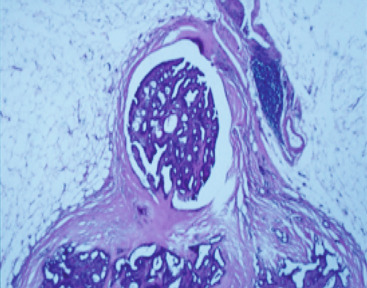
Less common are peripheral papillomas. Ohuchi and colleagues reported that 6 of 25 patients with multiple peripheral papillomas had associated DCIS. In their series of 77 patients with papillary lesions, Cardenosa and Eklund found that 18% of patients have multiple peripheral papillomas. Only one of these patients had nipple discharge as a presenting symptom.
Nipple adenoma or florid papillomatosis of the terminal portion of lactiferous ducts is also associated with bloody nipple discharge. Occasionally, intraductal papillary carcinoma and invasive ductal carcinoma may arise in nipple adenomas.
Duct Ectasia
Ectasia is a dilation of ducts with loss of elastin in duct walls and the presence of chronic inflammatory cells, especially plasma cells, around duct walls. Theories of causation range from transudation of secretions sequestered in ducts dilated from previous pregnancy to primary periductal inflammation. Microscopically, the ductal epithelium is not hyperplastic and may be thinned out or completely absent. Sloughed epithelium may be seen in ductal lumens. Lipid-laden foamy histiocytes can be seen within the duct lumen and in adjacent stroma. Intraepithelial histiocytes can also be seen. Cytologically/histologically, the duct contents comprise proteinaceous debris, lipid-containing histiocytes ( Fig. 4.12 ), cholesterol crystals, and calcification (duct ectasia).
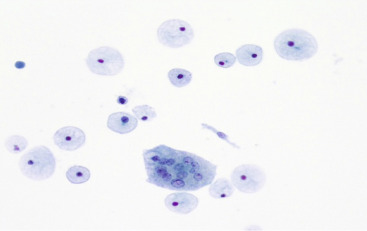

Stay updated, free articles. Join our Telegram channel

Full access? Get Clinical Tree





